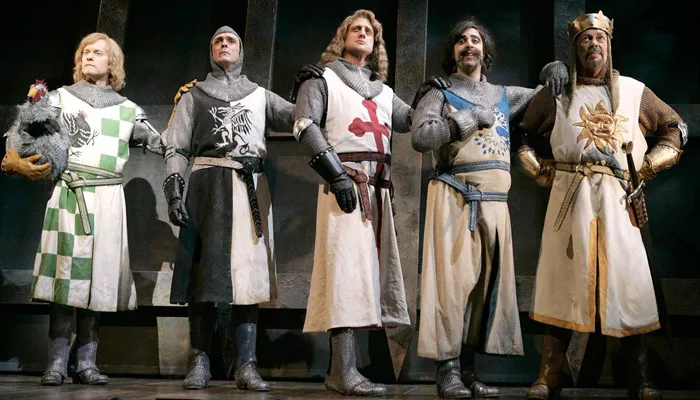Fifty years after its release in April 1975, Monty Python and the Holy Grail remains one of the most celebrated comedies in film history. Made on a tight budget by a British television sketch group, the film defied expectations and has since become iconic. Terry Gilliam, who co-directed the film with Terry Jones, explains why the movie still resonates. “Every time I watch it, I’m amazed by how wonderful it is. It’s still so funny, and I love everything about it,” Gilliam tells the BBC.
The Pythons first gained fame in 1969 with Monty Python’s Flying Circus, a BBC sketch comedy series. Five of the six members—Terry Jones, Graham Chapman, John Cleese, Eric Idle, and Michael Palin—came from student comedy societies at Oxford and Cambridge. The sixth member, Gilliam, an American who moved to the UK, created animated segments that connected the group’s surreal sketches. In 1971, they released a film, And Now for Something Completely Different, which compiled sketches from their TV show. However, they wanted to make something bigger—a feature film.
“Not everyone was keen on doing a film,” recalls Palin. “John was busy with Fawlty Towers, Eric had other projects, but the two Terrys wanted to direct a film, and I loved cinema, so it felt like the only way forward.” Palin adds that they didn’t want to make just another string of sketches but aimed for a full cinematic experience. “No other TV series had made that leap to the big screen, so we thought we’d give it a shot.”
Though Chapman and Jones have since passed away, and Cleese and Idle weren’t available for the BBC interview, Gilliam and Palin shared fond memories of Holy Grail. Palin was calm and thoughtful, while Gilliam was full of excitement as he laughed and reminisced about the film’s creation.
Palin explains that Jones had previously made historical sketches for a series called The Complete and Utter History of Britain, and Jones later became an acclaimed medieval historian. But that wasn’t the main reason they chose King Arthur’s legend for their first feature film. “We needed something that used all six of us,” Palin says. “The Round Table was perfect because we could each play a knight. Plus, the Grail legend was familiar to everyone, yet no one really knew much about it. It gave us creative freedom to tell any kind of story.”
Despite its comedic absurdity, Monty Python and the Holy Grail was full of memorable and unconventional moments—faux-Swedish subtitles, Gilliam’s signature animation, the Trojan Rabbit, the Knights Who Say “Ni!”, and debates about swallows and coconuts. It was unlike any film before it, and its oddity may explain why the BBC initially refused to fund it. With the help of theatrical impresario Michael White, the team raised money from some unlikely backers, including rock bands like Led Zeppelin and Pink Floyd.
Palin jokes, “Led Zeppelin gave us £50,000—look where they are now!” Gilliam adds, “Thank God for rock ‘n’ roll!”
The Pythons’ creative freedom was a major benefit of these unconventional backers. “Looking back, it felt pure,” says Gilliam. “We were just trying to make ourselves laugh and say interesting things. There were no outside pressures. The six of us made the decisions. Musicians often get that freedom, but not many filmmakers do.”
However, the low budget—less than £300,000—meant the team had to get creative. For example, they couldn’t afford horses for the knights, so they used coconut shells to mimic the sound of hooves. They also faced a setback when they were denied permission to shoot at several castles in Scotland, but they cleverly filmed Doune Castle from different angles to make it look like multiple locations.
“What I love is that Doune Castle now benefits from the Python legacy,” says Palin. “It’s a tourist hub, and it’s the only castle gift shop that sells pre-cut coconut shells.”
Despite its modest budget, Monty Python and the Holy Grail still looks like a genuine period epic, thanks to its atmospheric Scottish locations. Gilliam explains that he and Jones were frustrated with the low-quality sets and lighting in their TV shows. Both were fans of the painter Bruegel and filmmaker Pasolini, and they wanted to bring that level of texture and authenticity to the film. “What made Holy Grail unique was that some of us were serious historians and filmmakers,” Gilliam says. “We wanted the film to have that sense of reality, even in the absurdity.”
Monty Python and the Holy Grail remains a groundbreaking work of comedy and filmmaking, its mix of low-budget ingenuity and high artistic ambition ensuring its place in cinema history.
Related topics:
What’s Leaving Netflix in August 2023: Mean Girls, Sleepless in Seattle, and More
Indie Horror Film “Unholy Song” Draws Inspiration from Biblical Exorcism
Ma Dong-seok Stars in Action-Thriller ‘Holy Night: Demon Hunters’

